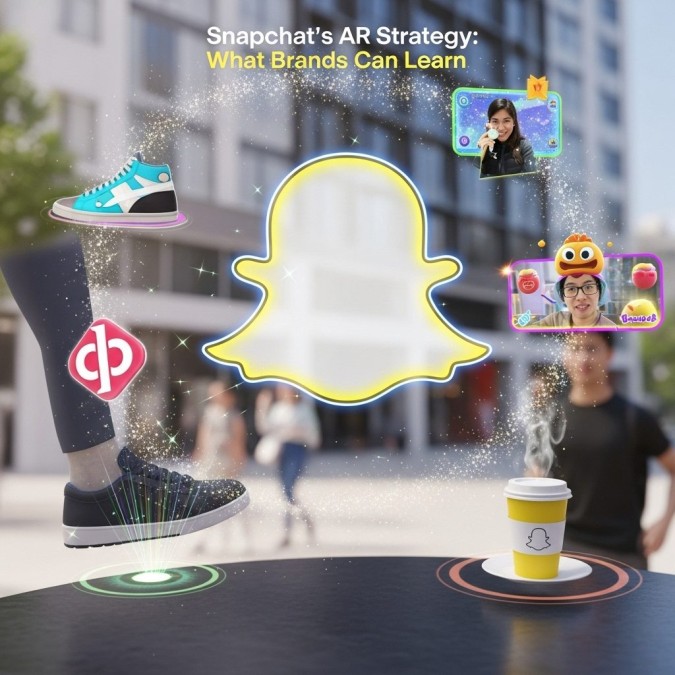Snapchat’s AR Strategy: What Brands Can Learn
In the ever-evolving world of digital marketing, few platforms have embraced augmented reality (AR) as boldly and effectively as Snapchat. While many brands still treat AR as a novelty or a one-off campaign tool, Snapchat has built an entire ecosystem around it—one that’s reshaping how users interact with content, products, and even each other.
As we step into 2025, Snapchat’s AR strategy offers a masterclass in immersive engagement, user-generated creativity, and brand integration. This blog explores how Snapchat has positioned itself as a leader in AR, and what brands—big or small—can learn from its approach.
🔍 Section 1: The Evolution of Snapchat’s AR Ecosystem
From Filters to Full-Fledged AR Experiences
Snapchat’s journey with AR began with playful filters—dog ears, rainbow vomit, and face swaps. These early lenses were fun, viral, and highly shareable. But beneath the surface, they laid the groundwork for something much bigger: a platform where AR wasn’t just decoration, but interaction.
By 2017, Snapchat launched Lens Studio, a free desktop app that allowed creators and developers to build custom AR experiences. This democratized AR creation, turning Snapchat into a crowdsourced innovation engine. Today, Lens Studio supports:
- Face tracking, hand tracking, and body segmentation
- World lenses that anchor AR objects in physical space
- Voice and gesture recognition
- Real-time data integration (e.g., weather, location, time)
Snapchat’s AR isn’t just visual—it’s context-aware, responsive, and deeply personalized.
Snap Map and Localized AR
Another key innovation is Snap Map, which lets users see where their friends are and explore local content. Brands can now create location-based AR lenses that activate only in specific areas—perfect for retail stores, events, or city-wide campaigns.
For example:
- A coffee shop might offer an exclusive AR coupon when users are nearby.
- A music festival could launch interactive AR scavenger hunts across the venue.
- A fashion brand might create virtual try-ons that only work in flagship locations.
This blend of geolocation + AR turns physical spaces into digital playgrounds.
AR Shopping and Virtual Try-Ons
Snapchat has also leaned heavily into AR commerce. Through partnerships with brands like Prada, MAC Cosmetics, and Nike, users can now:
- Try on makeup, sunglasses, or sneakers virtually
- See how furniture fits in their room
- Swipe through product variations in 3D
These experiences are frictionless, fun, and conversion-friendly. According to Snap’s internal data, AR try-ons lead to 2.4x higher purchase intent compared to static ads.
📈 Section 2: What Makes Snapchat’s AR Strategy So Effective?
1. User-Centric Design
Snapchat’s AR isn’t built for brands—it’s built for users first. The platform prioritizes fun, creativity, and self-expression. Brands that want to succeed here must adapt to the culture, not impose their own.
- Lenses are designed to be playful, not preachy.
- Sponsored AR feels native, not interruptive.
- Users are encouraged to remix and share, not just consume.
This user-first approach creates organic engagement, where branded content becomes part of the conversation—not a billboard.
2. Creator Ecosystem
Snapchat has cultivated a thriving AR creator community. Through Lens Studio and programs like the Snap AR Creator Residency, the platform empowers artists, developers, and storytellers to build immersive experiences.
Brands can tap into this ecosystem by:
- Collaborating with AR creators for custom lenses
- Sponsoring creator challenges or contests
- Featuring user-generated AR content in campaigns
This decentralization of creativity leads to diverse, authentic, and culturally relevant content—something no in-house team can replicate at scale.
3. Seamless Integration with Commerce
Snapchat doesn’t treat AR as a gimmick—it’s a conversion tool. The platform has integrated AR into the shopping journey with features like:
- Product catalogs linked to lenses
- Swipe-up CTAs to purchase or learn more
- Pixel tracking for performance analytics
This makes AR measurable, scalable, and ROI-driven—key for brands looking to justify their investment.
4. Data-Driven Personalization
Snapchat’s AR experiences are powered by real-time data. Lenses can adapt based on:
- Time of day (e.g., sunglasses in the morning, party makeup at night)
- Weather (e.g., rain-themed filters vs. sunny beach scenes)
- Location (e.g., city-specific branding or offers)
This contextual relevance boosts engagement and makes each interaction feel tailored and timely.
🧠 Section 3: What Brands Can Learn—and How to Apply It
Lesson 1: Don’t Just Advertise—Entertain
Snapchat’s AR thrives because it’s fun. Brands must shift from “selling” to storytelling. Instead of pushing products, think about how to:
- Let users play with your brand
- Create shareable moments
- Build emotional connections through interaction
For example:
- A beverage brand could create a lens that turns users into animated fruit characters.
- A travel company might offer a lens that transports users to exotic destinations.
- A fitness brand could gamify workouts with AR challenges.
The goal is to become part of the user’s experience, not just their screen.
Lesson 2: Embrace Co-Creation
Snapchat’s AR success is rooted in community creativity. Brands should embrace co-creation by:
- Hosting lens design contests
- Featuring fan-made AR content
- Collaborating with micro-creators and niche communities
This builds brand loyalty and expands reach organically. When users feel ownership, they become advocates—not just consumers.
Lesson 3: Think Beyond the Campaign
AR shouldn’t be a one-off stunt. Snapchat treats AR as a core product feature, not a seasonal gimmick. Brands should:
- Build a long-term AR strategy
- Create reusable lens templates for different occasions
- Integrate AR into product launches, events, and customer service
For example:
- A skincare brand might offer monthly AR skin analysis lenses.
- A restaurant chain could use AR menus and seasonal promotions.
- A tech company might offer AR tutorials for new devices.
Consistency builds familiarity—and familiarity drives trust.
Lesson 4: Measure What Matters
Snapchat provides robust analytics for AR campaigns, including:
- Lens views and shares
- Engagement time
- Conversion rates
- Demographic breakdowns
Brands should use this data to refine their AR strategy, test new formats, and understand what resonates. AR isn’t just creative—it’s quantifiable.
Final Thoughts: The Future of AR Is Already Here
Snapchat’s AR strategy isn’t just about filters—it’s about redefining digital interaction. By blending creativity, technology, and commerce, Snapchat has built a blueprint for immersive brand engagement.
For marketers, the lesson is clear: AR isn’t a trend—it’s a toolset. One that can drive awareness, deepen relationships, and boost sales when used thoughtfully.
Whether you’re a global brand or a local startup, Snapchat’s approach offers powerful insights. The key is to think like a user, create like a storyteller, and measure like a strategist.
Because in the world of AR, the brands that win aren’t the ones with the loudest ads—they’re the ones that make people smile, share, and come back for more.



